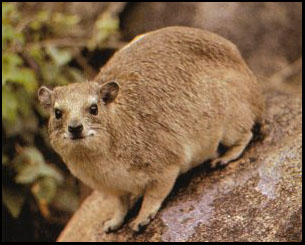
HYRAX [hyrax] , name for rabbit-sized mammals of Africa and SW Asia comprising the family Procavidae. Although rodentlike in appearance, hyraxes are hoofed mammals, or ungulates (see Chordata ), most closely related to elephants and sea cows. The hyrax, also called coney, has a squat, furry body, with short slender legs, short ears, and a short tail. It has small hooves on its toes, and moist padded soles that cling to steep surfaces by suction, making it an excellent climber. There are about 14 hyrax species, classified in two genera. The genus Procavia includes the ground-living species, sometimes called dassies. Dassies are rock dwellers and live in colonies of up to 50 animals; they are found especially in deserts and hills. Most species of the genus Dendrohyrax are arboreal and are known as tree hyraxes; they are the only tree-dwelling hoofed mammals. Tree hyraxes are solitary and nocturnal; they are confined to forested regions of Africa. Hyraxes feed on seeds, fruit, and leaves, and in large numbers can be serious agricultural pests. They are classified in the phylum Chordata , subphylum Vertebrata, class Mammalia, order Hyracoidea, family Procavidae.
On this thread I will introduce exotic animals to the members of A2K. I will include a brief description of the animal (as above) and will field any appropriate question regarding the subject at hand.
Tragically, the hyrax in the above photo met an unfortunate demise at the paws of a leopard....

This is an example of the dangerous life the hyrax leads.
I've been thinking about the lack of recognition the hyrax receives within the general populace, and, surprisingly, many people have never heard of the hyrax.
Today's assignment: I would like each A2Ker to introduce the hyrax into conversation today. For example, you are at dinner: set your fork down for dramatic effect, pause for a second as if you are collecting your thoughts, and then say to your dinner mates, "It is my understanding that the hyrax population worldwide is being altered dramatically by unstable weather patterns."
The conversation should move nicely from that point.